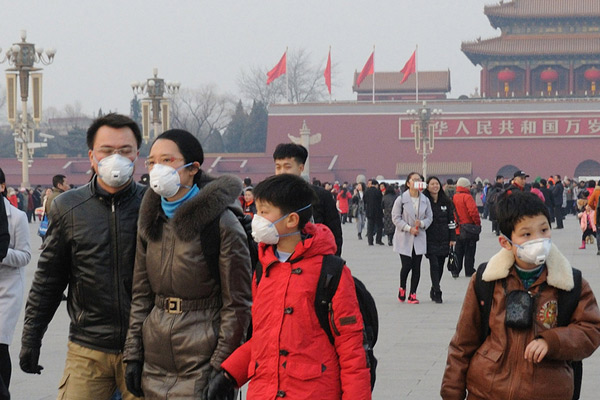 |
|
Heavy smog prompted travelers to wear protective masks while visiting Tian'anmen Square in Beijing on Feb 11, 2016.[Photo/IC]
|
The national environmental authority has launched a new plan that targets Beijing, Tianjin and four neighboring cities with tough restrictions in an effort to curb severe smog in the northern region.
The six core cities will have a unified response against severe air pollution by March 15, the first step in coordinating regional efforts to determine alert levels and issue responses, said Chen Jining, minister of environmental protection, on Thursday.
In addition to the capital of Beijing and the northern major port hub of Tianjin, the cities are Baoding, Langfang, Tangshan and Cangzhou in Hebei province, all of which have frequently seen severe smog since 2013.
Among them, Baoding has ranked at the bottom for two consecutive years among the 74 major cities in terms of air quality, according to an annual report released by the Environmental Protection Ministry.
The Beijing-Tianjin-Hebei area, known as the trilateral region, has seen worse air quality than the cities in two other industrial regions — the Yangtze River and Pearl River deltas.
The minister has recently reiterated that regional efforts are needed to curb smog and has highlighted the urgency of addressing pollution in the core cities.
"Under the unified response system, the six cities will adopt the same alert, red or orange, and follow the same standards, instead of issuing alerts separately," the minister said at a news conference held by the State Council Information Office.
Chen said the unified response standards will eventually cover the whole region.
In December, three spells of smog hit the region, driving readings of major airborne pollutants to alarmingly hazardous levels, and many cities issued alerts.
The capital issued the highest response, red alert, twice — implementing tough restrictions like suspending industrial production and slashing by half the number of vehicles allowed on roads.
The regional coordinated restrictions improved the effectiveness of the alerts in reducing pollution, especially in the latest spell of severe smog, according to the ministry's assessment reports on the two red alerts.
In addition to the growing attention to the six core cities, the ministry also emphasized existing joint efforts to control smog in the northern trilateral region, Chen said.
By the end of January, it had established a regional network to share monitoring information about major companies in polluting industries.
Additionally, the governments of Beijing, Tianjin and Hebei province have conducted joint inspections and held regular regional meetings. Among the next targets, the small yet heavily polluting plants scattered around the region will be a major one, the ministry said.
Last year, only 21.6 percent of the 338 monitored cities reached their targets for air quality standards. But China has seen a gradual improvement in air quality, especially in the reduction of concentration of PM2.5 — airborne pollutants with a diameter of less than 2.5 microns that can penetrate the lungs and harm health — which fell by 14.1 percent year-on-year, the ministry said.
With the economy weakening, many local governments are reluctant to take steps to reduce air pollution, since restrictions could shut down companies and affect economic growth and society, Chen said.
But it's time to change the growth concept to put more focus on sustained growth with a better environment, the minister added.
By Zheng Jinran (China Daily)
Using WeChat? Scan QR Code or Press the Fingerprint Below ↓
--- (Or ADD WeChat ID: OKOKOKOKnet)
